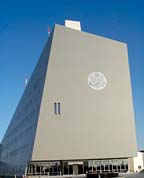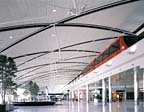Comfort Plus Security

While achieving optimal climate control requires a number of components working together, creating a secure facility is significantly more complex. The safety and security of a building is dependent on a number of different systems and sub-systems: physical and electronic security, fire and life safety, emergency power and lighting, elevator controls and even HVAC systems.
Building background
Before looking at how to create an integrated building, it is necessary to understand the basics of building security. Physical security is the use of doors, windows, walls, floors, roofs, locks, fences, gates and even landscaping to keep intruders out or to provide containment. It is greatly enhanced through the use of electronics such as access control systems, video surveillance and electronic sensors.
Fire and life safety systems employ both automatic and manually-activated devices to initiate predetermined actions – from sounding an evacuation signal within the building, to recalling elevators, to starting a smoke management system in order to evacuate smoke from one floor or compartment and for pressurizing another.
Emergency power keeps critical systems running in the event that a facility loses power from a utility. Critical systems vary; but they typically include elevators, lighting, fire protection systems and smoke management systems. Hospitals, laboratories and some industrial facilities usually have critical systems in operating rooms, fume hoods and areas where there are hazardous processes – areas that are essential to the preservation of life and property.
Lighting systems are a vital aspect of safety and security. Minimum lighting levels must be maintained during normal as well as emergency conditions for every type of occupancy. A well-designed lighting system also can deter crime and help in the investigation of crimes when paired with video surveillance; a poorly lit environment always causes occupants to feel unsafe or less secure.
Smart buildings with fully integrated systems and a single command and control platform are on the top of building managers’ wish lists. Creating a smart building is easy if the facility is about to be built – just include the features in the construction. But incorporating these features into existing buildings poses numerous challenges.
Here’s why: although existing facilities may already have some security systems, as well as systems dedicated to information technologies and those related to the building’s main use – manufacturing, entertainment, research – these systems are likely to speak different languages. The result is a virtual Tower of Babel; without the necessary translators, these various systems can’t communicate with each other.
For example, the lighting panel may speak LonTalk, the power meters may speak Modbus, the fire panel and lights may speak BACnet and the security system may speak a proprietary language.
The oldest method of integration is hardwired points. Although it is a reliable solution, it’s not always cost-effective or efficient. Hardwired points allow an “off” or an “on” value, but require an input/output set for each point to be exchanged. Hardwiring is required for some life/safety sequences, but their use should be limited to those applications that require them.
Look at drivers
The next challenge in turning old buildings into smart ones is software “drivers” – code that takes a message from one system and translates it into the language of the receiving system. Drivers also allow the exchange of detailed information between systems and can even pass alarm information.All drivers, however, have their drawbacks. To configure a driver, representatives from both vendor systems often need to coordinate; if one vendor upgrades its system after the initial setup, the driver may no longer function properly.
In response to the flaws of hardwired points and drivers, manufacturers are using open architecture (or open protocol systems) – a lingua franca that allows systems made by different vendors to communicate seamlessly.
This initiative, though, has not been without its shortcomings. Some open protocols only communicate with systems designed by the same manufacturer; others are multi-lingual. Some open systems only permit data sharing; others boast valuable services such as alarming, scheduling, trending and device management between systems.
Interoperability is best achieved through the use of open architecture systems that support multiple services. This enables a single user interface to be the primary monitoring and response center.

Open systems
Since the openness of the system is critical for seamless communication between its various parts, it’s vital that you select an appropriate solution.Make sure that a protocol goes beyond the standard data-sharing functions; without these services, the total system loses functionality. When using a single-user interface to manage an entire facility, it will be important to be able to receive alarms, trend data, edit schedules and manage devices. Purchasers should be wary, as some protocols only provide a data sharing service.
With data sharing, it may be possible to create a graphic with points from all the building systems, and read and write values, but not edit schedules, retrieve trend data and manage devices.
Unfortunately, security manufacturers have not adopted standard communication protocols. Manufacturers’ primary focus on standard protocols for security systems has been at the card and reader level (ABA, Wiegand) and the biometric level (BioAPI, BAPI, CDSA/HRS, CBEFF, X9.84, M1), but not at the device and system levels. This has been a protectionist move on the part of security vendors; manufacturers have successfully countered customers’ desires for competitive project bidding by raising the specter of security holes in the system.
There is justification for the argument; when many of the building automation open protocols were developed, security applications were not initially considered, and protecting the data was not part of their design. Thus, an individual using a compatible tool could theoretically plug into a vendor’s network and take control of all of the devices. This vulnerability is justifiably unacceptable for security applications.
Life-safety systems, however, do use open protocols as they can present critical data as “read-only,” while fire panels make critical decisions on their own and typically don’t need to be re-programmed on a regular basis.
With an access control system, decisions and programming are made from a workstation, which needs to communicate instructions and updates to the field panels securely. An access control system is programmed whenever a card record or a door schedule is changed. Information about who enters or leaves a facility is highly sensitive and should be available to only the appropriate operators. The same is true for viewing live and recorded video surveillance images.

Single open protocol
Fortunately, several manufacturers, industry groups and end users are developing solutions to mitigate these deficiencies in security systems. Perhaps the best solution to secure the network is the development of standard encryption methods. The end result would be an application-focused design that allows security devices from several manufacturers to interoperate using current and newly created services.Ideally, all the systems in a building would communicate using a single open protocol. The building owner would be able to select vendors based on service and product features, and have the freedom to change vendors without sacrificing compatibility with existing equipment.
Although some protocols can accomplish some tasks, none can presently meet all consumer needs. And even if one were available, manufacturers wonder how many building owners would upgrade from a multi-lingual facility to a single protocol solution.
Multi-lingual solution
Multi-lingual is a new breed of system that can deliver effective single-seat building management because it speaks more than one protocol simultaneously without a gateway.For example, a multi-lingual system may consist of a BACnet or LonTalk core network and proprietary access controllers. Both types of controllers are managed from the same workstation and utilize the same alarm system. The network controller can directly send data to and from the proprietary controllers on the same network.
Furthermore, both the network and proprietary controllers share the same programming language. Therefore, code can be copied/pasted from the proprietary controller to the network controller, making the transformation easier.

Gateways
Multi-lingual systems bring a significant benefit when used as a proprietary language for access control, security video and intrusion systems. These systems can be combined into a single, cohesive system. One multi-lingual workstation and one multi-lingual controller make this setup possible. The access control and digital security video systems can deliver content to a network-compatible system in a secure manner, because they can utilize data security technologies of the proprietary systems.Gateways can have a role in determining the best method available to integrate building systems. Prospective purchasers should go down the following checklist to determine how to integrate a piece of equipment into the total system, stopping at the first possible solution:
- Is there a single open protocol option?
- Is there a multi-lingual solution?
- Is there a gateway solution?
- Is there a hardware solution? How many points?
- Lastly, consider replacing the
equipment with an open protocol
product.
Although there are promising developments in open, secure system architecture for total building integration, multi-lingual systems currently deliver the open architecture solutions building owners desire – including the network security features of a proprietary security system. A multi-lingual system also allows the end user to go beyond the limits of traditional security and building automation systems and create a comfortable and secure environment for a building’s occupants and other assets.
Creating integrated buildings that are comfortable and secure is a challenge. But by using smart integration methods, a facility can have climate, lighting, security video, access control, intrusion and fire systems that work together and deliver the level of safety and comfort today’s building occupants demand.
Sidebar
Open System QuestionsAsk a prospective vendor the following questions:
- How many vendors use your system’s protocol?
- Is the protocol freely distributed?
- Is the protocol hardware chip independent?
- Is the protocol software independent?
- Is the protocol developed in an open manner?
Ask a vendor this next set of questions relative to data sharing
- Is the system capable of data sharing (read/write points)?
- Can I create and edit schedules between the various systems?
- Will I have trending capabilities for all systems and devices?
- Can I manage alarms and events on all of my systems?
- Will I have complete device management capabilities regardless of the system or level on which the device resides?
Looking for a reprint of this article?
From high-res PDFs to custom plaques, order your copy today!






